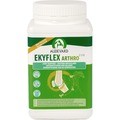What is tendonitis?
The tendon is a tissue capable of returning more energy than it receives. With each stride the horse takes, the musculoskeletal system dampens the force of the horse’s muscle contraction, weight and speed. This energy is stored and immediately returned for propulsion. The tendons are like powerful springs, pressed to the maximum, and then released.
Tendonitis is an inflammation of the tendon, and can be recognised by several signs: heat, pain and swelling. Tendonitis is a self-aggravating phenomenon if exercise or stresses persist. Inflammation should therefore be stopped as soon as possible. Tendonitis in horses corresponds to a partial or total rupture of the affected tendon’s collagen fibres. According to the degree of rupture, there are four types of tendonitis:
Type-I tendonitis: partial rupture with possible pain at the beginning of the horse’s work, disappearing as the horse warms up.
Type-II tendonitis: partial rupture with persistent pain during the horse’s work, which may increase with more intense effort.
Type-III tendonitis: partial rupture with permanent and intense pain, impeding the horse’s training.
Type-IV tendonitis: total rupture of the fibres, rendering all movement impossible and requiring possible surgical intervention.
What causes tendonitis in horses?
The causes of tendonitis are multiple. The most common is fatigue of the tendon caused by fatigue in the muscle from which it originates. The damaged fibres become inflamed and weakened.
With each of the horse’s movements, the tendon no longer functions normally and perpetuates the phenomenon. Any repeated, prolonged and/or unusual exercise, particularly if intense, may provoke tendonitis. It is for this reason that training management is so important.
The horse’s anatomy is another possible cause of tendonitis, as certain horses, who may be pigeon-toed or splayfooted, tend to develop tendonitis more frequently than others because of the poor distribution of loads and forces involved in their movement.
Finally, nutrition and soil quality play a major role, both when it comes to managing the horse’s general condition and level of training, and in terms of support and resonance on the ground.
Tendonitis in horses: diagnosis and examinations
Diagnosis is based on a veterinary examination carried out in several stages.
Firstly, the vet will carry out a three-step clinical examination: a static visual examination with the horse at a standstill (examining the horse’s conformation and possible zones of abnormal deformation), followed by palpation and a dynamic examination to evaluate any musculoskeletal discomfort. Secondly, imaging will be carried out – more specifically, by ultrasound – offering a significant advantage when it comes to locating the injury and evaluating its degree of severity.
How to treat tendonitis in horses
No matter the treatment implemented, rest is vital and highly beneficial. This allows tendon reconstruction to begin. The vet will prescribe a rest period, varying in length and strictness according to the location and severity of the tendonitis: ranging from several days to several months (or even a whole year), potentially allowing moderate and controlled exercise or use of the paddock, though absolute rest in the stable is sometimes necessary.
However, rest should not be the only treatment. Letting nature run its course is often not enough for adequate recovery, and other more innovative techniques can improve the quality of healing over time and limit the risk of recurrence. The aim is to recreate the subtle balance between mechanical strength and elasticity for the exercise to which the tendon will be subject.
To support the tendon’s healing, and according to the type of tendonitis suffered, vets may use the following techniques:
- Oral and injected anti-inflammatory drugs.
- Regenerative medicine injected into the tendons.
- External local treatment, plasters, clay, showers and local anti-inflammatory gels. The aim is to limit inflammation and facilitate drainage of the swelling and haematoma in and around the injury.
- Potentially, and more rarely, surgery may be required – cleaning the tendon and removing the haematoma and necrotic tissue for faster reconstruction.
The tendon tissue and fibres must also be reconstructed in order to restore quality tissue and ensure functional repair. The main techniques used by vets include:
- Regenerative medicine: PRP (injection of platelet-rich plasma into the wound, containing growth factors that stimulate the synthesis of type-I collagen)
- Stem cells
- Cellular re-education is essential. This may be associated with equine physiotherapy. Progressive re-tensioning of the wounded tendon in order to facilitate the axial orientation of fibres and their organisation into bundles (through movement on solid ground, in water, manipulations, massages, laser treatment and shockwaves, etc.).
- Horseshoes can also play an important role. These can be adapted to the type of tendonitis and make it possible to limit pressure on the tendon during re-education.
Nutritional aids may also be recommended by your vet. These products aim to support the horse’s body during tendon healing.
How to prevent tendonitis in horses
In terms of prevention, training on good-quality soil is essential in order to maintain your horses’ ligaments. Regular activity, always preceded by a proper warm-up, is another good way to limit risks.
Please find Audevard's Ekyflex Tendon on our website. This provides nutritional support to your horses ligaments and tendons.
Written by: Audevard Laboratories (Guest Author) (Guest Author)





